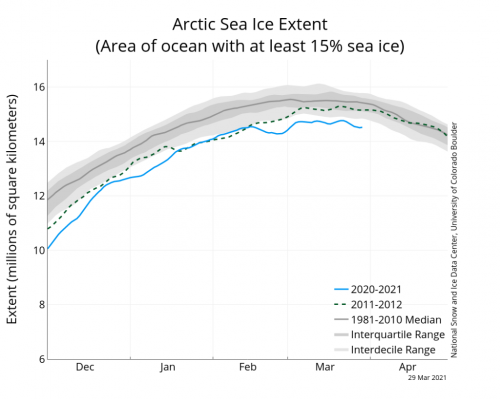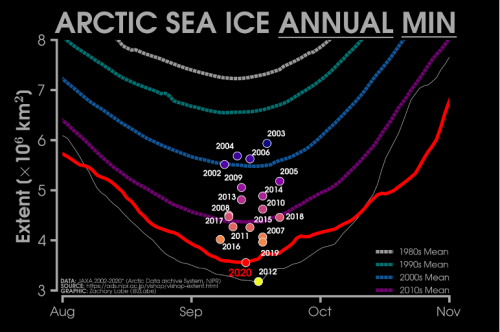Arctic Sea Ice Reaches Seventh Lowest Mark on Record, Finds NASA

Image Courtesy: NASA's Scientific Visualization Studio
The sea ice in the Arctic has reached the maximum extent for the year 2021. This ice has been marked as the joint-seventh lowest on record, tying with the year 2007. This is indicative that the Arctic is losing more ice than what can be recovered.
The ice peaked on March 21 and the span of it has been calculated as 14.77 million square kilometres. This is according to NSIDC(National Snow and Ice Data Center) supported by the NASA (National Aeronautics and Space Administration).
The NSIDC says that this is an “uneventful maximum.” However, it was followed by an exceptional Arctic’s summer minimum in September.
Every year, the Arctic gets snow during winter and reaches its peak around March. The maximum ice extent is the maximum amount of sea ice that is received in a year, mostly in February or March. The ice melts through spring and summer and reaches an annual minimum, mostly during September. The amount of maximum appears to be low for the year 2021.

Image Source: Down to Earth.
The NSIDC says that, this year, the maximum ice extent was 870,000-kilometre square (Km2), which is below the average maximum that was observed during the period 1981-2010 and 360,000 Km2 above the lowest maximum recorded in the year 2017.
Ted Scambos, a senior research scientist at NSIDC, was quoted to have said, “The sea ice maximum in 2021 is not close to a record, but still quite low compared to any year prior to 2000.”
According to NSIDC, the low ice extent was due to the phenomenon known as the ‘Arctic Oscillation’, especially because of the positive phase of the Arctic Oscillation. During this phase, strong winds circulate around the North Pole. The strong winds confine colder air across polar regions.
This pattern of wind transport ice from the Siberian coast, out of the Arctic Ocean, and across the Pole. As a result, thinner ice, more prone to melting, is left over in the Siberian coast.

Image: Arctic Sea ice extent during summer minimum for different years. Image source: Down to Earth.
According to NSIDC, “From 13 October into early November, the daily sea ice extent was the lowest for that day in the satellite record. The low sea ice extent left vast expanses of open water across the Arctic throughout November, which lost heat to the atmosphere and caused hotspots to form near the surface of the ocean.”
Get the latest reports & analysis with people's perspective on Protests, movements & deep analytical videos, discussions of the current affairs in your Telegram app. Subscribe to NewsClick's Telegram channel & get Real-Time updates on stories, as they get published on our website.
























